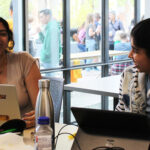
Work on contaminant removal methods earns research paper awards
Research papers detailing proposed new methods for the removal of environmental pollutants and contaminants earned awards for Arizona State University postdoctoral research associate Aura Ontiveros-Valencia and environmental engineering doctoral student Devyn Fajardo-Williams at a recent international environmental science and engineering conference.
The Remediation of Chlorinated and Recalcitrant Compounds conference in Monterey, Calif., explored advances in technologies and methods that offer potential solutions for cleaning up areas that have sustained environmental damage due to chemical contamination.
Ontiveros-Valencia’s paper reported on her research project using membrane biofilm reactors in which a gathering of microbes develops as a thin layer on the surface of hollow membranes.
Those membranes deliver hydrogen gas, which is the source for electrons that microorganisms need to transform the pollutant to safer substances, she explained.
Through this method “microorganisms transform selenate to elemental selenium. Elemental selenium was located within the biofilm matrix, and we provide evidence on its location by imaging the biofilm with scanning electron microscopy and transmission electron microscopy,” she explained. “Elemental selenium has economic value if we can recover it after microbial transformation in the membrane biofilm reactors.”
Fajardo-William’s award-winning research paper detailed the design and operation of a biological reactor for the detoxification of trichloroethene (TCE), a common groundwater contaminant. The microorganisms used in the reactor can convert toxic, carcinogenic TCE to non-toxic ethane. The reactor can produce high-density microbial cultures that dechlorinate TCE at unprecedented fast rates, and convert 97 to 99.9 percent of toxic TCE to non-toxic ethane.
Ontiveros-Valencia came to ASU in 2007 from her home in Mexico. In 2009 she received a master’s degree in applied biological sciences and began doctoral studies in ASU’s School of Sustainability. The multidisciplinary nature of the program enabled her to combine studies in various disciplines, including courses in the civil, environmental and sustainable engineering program in the ASU’s Ira A. Fulton Schools of Engineering.
Her doctoral research focused on understanding the behavior of microbial communities to reclaim polluted water with nitrate and perchlorate. She was co-advised on her doctoral work by professor Bruce Rittmann and associate professor Rosa Krajmalnik-Brown, faculty members in the School of Sustainable Engineering and the Built Environment, one of the Fulton Schools of Engineering.
Ontiveros-Valencia received her doctoral degree in sustainability in the spring of this year. She now works at the Biodesign Institute at ASU in the Swette Center for Environmental Biotechnology, under the direction of Rittmann and Krajmalnik-Brown. Rittman is director of the center. Krajmalnik-Brown, a senior sustainability scientist, leads a research group in the center.
Fajardo-Williams came to ASU from St. Lucia in the Caribbean, the sixth member of her family to attend ASU. She earned bachelor’s degrees in chemical engineering and economics in 2012 before beginning a doctoral program in 2013.
She is expanding on work she began a few years ago in Krajmalnik-Brown’s Swette Center lab through the Fulton Undergraduate Research Initiative. She is continuing to do her doctoral research as member of the same lab team.
Media Contact
Joe Kullman, [email protected]
(480) 965-8122
Ira A. Fulton Schools of Engineering





































